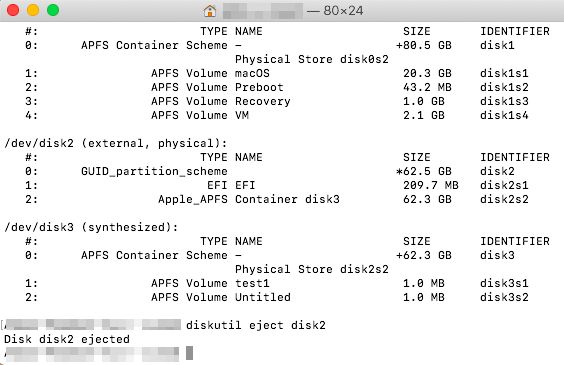
- #MAC OS LIST HARD DRIVE FILES USING TERMINAL HOW TO#
- #MAC OS LIST HARD DRIVE FILES USING TERMINAL MAC#
Rsync is a really powerful program that can do a whole lot of stuff, the command I wrote above is a very simple one designed to copy data quickly and easily without too much fuss. To Check for Errors, there is a file on your Desktop called rSyncErrors.txt, this will contain any errors during the copy and why they failed to copy. Just wait until it has finished.Īt the end you will see a summary of how much has copied and how fast it went. You will see the files transferring as they go, if there’s a lot of files it’ll fly by pretty quickly. Step 5: Add the following to the end of the command (note the space after the destination folder): 2> ~/Desktop/rSyncErrors.txt This is the folder you want the files to go to. Step 4: Drag and drop the DESTINATION folder onto the Terminal window. This is the folder that has the items you want to copy. Step 3: Drag and drop the SOURCE folder onto the Terminal window. (note there is a space at the end of the command and the P is a capital letter) rsync -ahP Step 2: Type the following into Terminal, but do not press Enter. You can also open it the quick way by going to Spotlight and typing: terminal Step 1: Open Terminal.app It is located in Applications/Utilities/ This is a beginner to intermediate guide and doesn’t cover some of the more advanced features of rsync. This command unmounts the external drive.

For example to see list of files of your home directory type this into command line in Linux and Mac. Type unmount /dev/disk4s1 and hit Return. File share settings are: Add a Directory: Click + and navigate to the directory you want to add. Note down the file system identifier of the external hard drive, say /dev/disk4s1. In the Terminal window, type df h and hit Return.
#MAC OS LIST HARD DRIVE FILES USING TERMINAL MAC#
It’s especially handy for copying files while skipping errors, corrupted files and getting past some permissions errors. Steps to repair Mac external hard drive by using Terminal are as follows: Go to Finder > Applications > Utilities > Terminal.

It’ll skip any errors and log all the failed copies to a file for you to check through.
#MAC OS LIST HARD DRIVE FILES USING TERMINAL HOW TO#
This guide covers how to copy files on a Mac using an external drive or any connected network drive. If I need to copy a bunch of files where I’m likely to come across errors copying, I’ll use rsync!

There’s a lack of good file copy utilities on Mac like there is for Windows (eg.


 0 kommentar(er)
0 kommentar(er)
